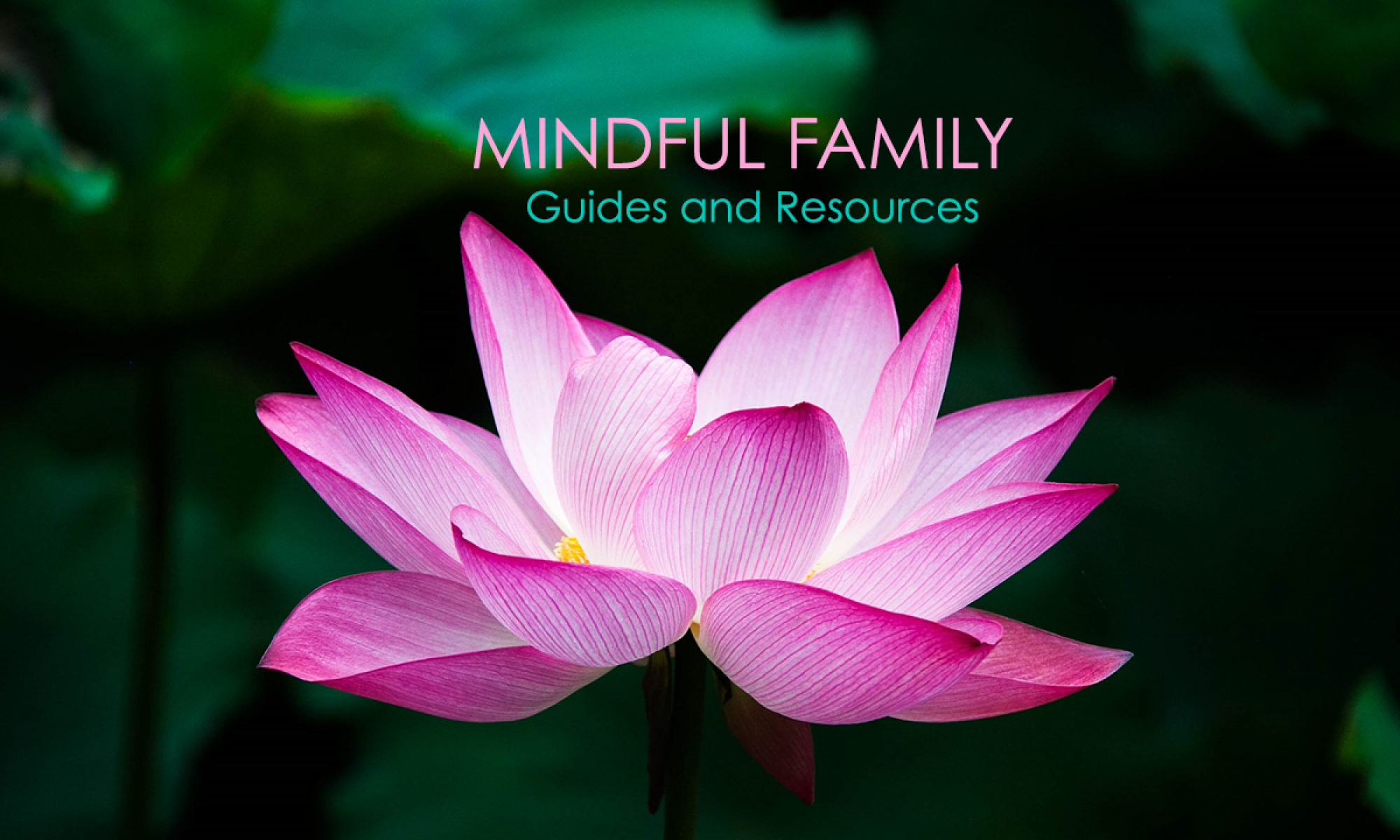By Jenny Anderson and Michelle Harbott
Having a Mindful Childbirth
The process of childbirth is not for the faint-hearted. Whether women decide to use pharmaceutical or non-pharmaceutical pain remedies, vaginally delivering a baby can be a long strenuous journey. Luckily, there are many helpful tools to prepare for childbirth, one of them being mindfulness.

Mindfulness is the act of deliberate and open-hearted attention to the present moment that is unfolding, both in the external and internal world (Hughes, Williams, Bardacke, Duncan, Dimidjian & Goodman, 2009). It is cultivated through training of the mind and body using guided meditation and thoughtfulness. With practice, individuals can learn to cultivate moment-by-moment, non-judgmental awareness of their thoughts, feelings and body sensations as they arise. The practice of mindful birthing was developed by Jon Kabat-Zinn, PhD, at the University of Massachusetts Medical School in 1979 for the use of helping hospital patients to cope with pain (Szalinkski, 2018). It started as an adaption of the Mindfulness-Based Stress Reduction (MBSR) program to alleviate stress, depression, anxiety and pain. There are three components of pain: sensory, cognitive, and emotional (Figure 1). These components magnify each other, so increasing negative thoughts and anxious feelings increases pain sensation and the painful experience (Sheridan, 2016).
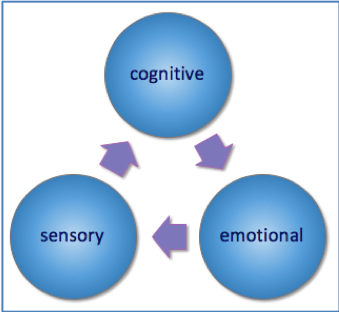

Fear and anxiety have been shown to magnify pain during labour and practicing mindfulness in preparation for childbirth can help decrease anxiety and empower a woman to feel more in control of her body during this very intense experience (Duncan, Cohn, Chao, Cook, Riccobono & Bardacke, 2017). Mindfulness is one’s ability to be completely present in the current moment and is the antithesis of being scatterbrained or on autopilot (Sheridan, 2016).

Strategy 1 – Breathing
Breathing strategies are widely recommended for a variety of relaxation, meditation and mindfulness practices. Some areas of focus are listed below and will aid in mindful breathing and can serve to help relax the woman in labour and provide a distraction from pain and the negative emotional and cognitive processes associated with it. Typically, women will determine for themselves what speed, depth and rate of breathing works best for them in labour; although care should be taken to stay within a range of ½ to 2x the normal rate of breathing so that adequate oxygen is being taken in (Amis & Green, 2014).
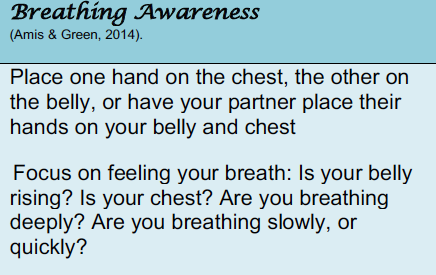
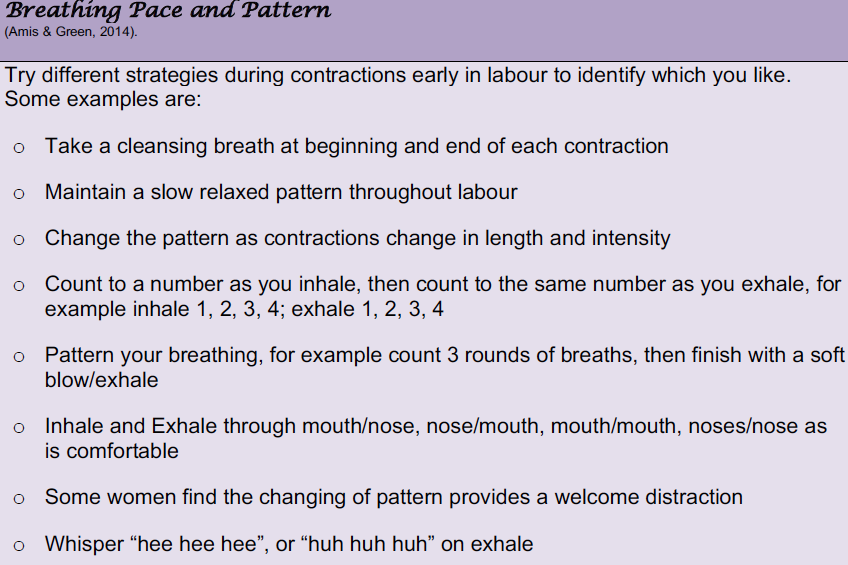
Click to view larger version of these instructions
Strategy 2 – Imagery and Visualization
Visualization allows a labouring woman to focus during labour, which can minimize fear and anxiety (Beaumont Hospital, 2018). Purposely directing thoughts to relieve stress can provide a sense of relief and relaxation (Perry, Hockenberry, Lowdermilk, Wilson, Keenan-Lindsay, & Sams, 2017). A variety of strategies can be employed where the woman thinks of relaxing imagery, or she can become mindfully aware of what her body is doing.

Some examples are:
● Visualizing rhythmic ocean waves
● Imagine being surrounded by your favorite colour. Think about breathing in a relaxing colour and having it extend to every part of your body, and then exhaling a colour associated with tension
● Visualize the pedals of a flower opening
● Try to picture your cervix ripening and opening
● Imagine your baby’s position change as it moves through the pelvis
● Visualize the baby coming down the birth canal. This has been known to enhance pushing efforts (Perry et al., 2017)

Strategy 3 – Observe your Pain
In order to manage the different aspects of the pain experience, one can use mindfulness to be aware of the emotional, cognitive and sensory component. This includes acknowledging the sensory perception can decrease the negative emotions like fear and anxiety that are often associated with pain (Sheridan, 2016).
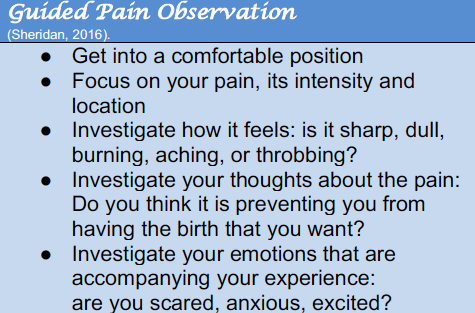
Strategy 4 – Biofeedback
In order for biofeedback to be effective, the woman is aware of her body and its response to pain and uses practiced techniques for relaxation. It uses mental processes of thinking and focusing to control body responses and functions to pain (Perry et al., 2017). For example, if the woman responds to contraction pain by tightening muscles, frowning, moaning and holding breath, her partner uses touch and verbal feedback to promote relaxation.
Strategy 5 – Yoga
The practice of yoga has been associated with pain relief and a reduced length of labour (Perry et al., 2017). Practicing yoga poses during labour can also help position the fetus into the correct position for delivery. Practicing yoga in the antenatal period has prepared women to cope better with the overwhelming sensations of labour for many years. Yoga brings awareness to the mind, body and spirit and can serve as a relaxation practice to prepare the body and mind for childbirth and beyond (Weller, 1981).

View Our Video: Mindfulness in Childbirth Exercise- A Guided Meditation During Labour
Video created by
Jenny Anderson and Michelle Harbott
2 mins, November 2018 in Adobe Spark Video
Mindful Childbirth Resources
Mindful Birthing
Training the Mind, Body and Heart for Childbirth and Beyond

This is a website dedicated to the Mindfulness-Based Childbirth and Parenting Program (MBCP), which was organized by Nancy Bardacke, a certified midwife, author and mindfulness teacher. Because it is promoting classes, there is some bias, however, there are videos, and free resources on the website that provide education and strategies for someone who is curious about what mindfulness in childbirth looks like. Classes are offered regularly and are scheduled in 9-week blocks, available across the United States, and internationally. The section of the website with the richest information is the Resources and Research section where there is a comprehensive list of links to academic articles, popular articles that can be accessed for free; additionally, there are links to books that can be purchased, and to affiliated organizations.
URL: http://www.mindfulbirthing.org
University of California San Diego Health

Sometimes academic sources are not very easy to read or navigate, but that is not the case with this university website. The section on Mindfulness Resources, is easy to get to and even easier to follow. There are many guided meditations and other resources that are simple to download and share and would be a useful tool for a labouring mother to have on her smartphone or other device. Clear, descriptive titles make the selection straightforward and the accessibility is a testament to the intentions of this institution which are “to further the practice and integration of mindfulness into all aspects of society,” as stated on their website.
URL:https://health.ucsd.edu/specialties/mindfulness/resources/Pages/default.aspx
The Chopra Centre

Calming and serene, this website instantly relaxes the reader. It provides simple-to-understand information on the effects of relaxation on mother and baby and offers step-by-step written instructions for guided meditation that can help reduce anxiety before labour. There are links to courses and events, and even products like massage oils and creams that can be purchased to assist in labour. The affiliation with Deepak Chopra lends credence to this resource as he is a prominent figure in mediation, mindfulness and alternative medicine.
URL: https://chopra.com/articles/meditation-for-childbirth-how-to-calm-your-nerves-before-labor
Northwest Mindful Birthing & Parenting

This website is affiliated with MBCP and provides links to sign up for the classes, but the homepage also serves as an introduction to mindfulness and its application to childbirth. Immediately upon looking at this resource there are a multitude of links to articles, awards, blogs, and online magazines. Not only does it provide a plethora of media options for the wide variety of parents, but it speaks to the credentials and reliability of the organization and the content. There is a tab for student resources, that is only accessible with an account, so there is likely supplementary information to the courses available online.
URL: https://www.nwmindfulbirthing.com
Mindful.org

URL: https://www.mindful.org/mindful-childbirth/
The Bonapace Method

This website offers an online course for couples to prepare for childbirth. There are many other resources within the website to ask questions and get personalized help. The online course covers topics of mindfulness such as pregnancy yoga poses, breathing to relax and control the mind, finding zen during pregnancy, and activating the gate-control system.
URL: https://www.bonapace.com/en/course-outline/
Manage the Pain of Labour with Meditation

The website has several guided meditations to try when preparing for childbirth. It also explains the benefits of meditation and different types of meditation that is easy to understand. Main points are bolded for emphasis in order to guide readers into different types of meditation such as deep breathing and visualization. These meditations have been known to lower blood pressure, heart rate and anxiety as they decrease stress hormones of cortisol and adrenaline.
URL: https://www.exploremeditation.com/meditation-manage-pain-labor/
Meditation and Mindfulness Made Simple

This website helps readers to learn to meditate and live mindfully. They provide hundreds of themed sessions such as stress, sleep, focus or anxiety. On their app, there are “bite-sized” meditations for busy schedules, and even guided meditations specially for childbirth. On a blog post, a woman claims that “it is of paramount importance to create space for mindfulness as part of the birth preparation and to cultivate mindful relationships with your partner, your family, and most importantly, yourself. Mindfulness may not give you the birth experience you want, but it helps you fall in love with the birth experience you get”. Headspace is a warm and friendly place to learn and practice the act of meditation online, in addition to a convenient app.
URL: https://www.headspace.com
Childbirth Connection

This is an excellent online resource for evidence-based information about maternity care practices in the United States and resources about pregnancy, childbirth and the postpartum period. It offers tools to plan your childbirth, starting off with choosing your healthcare provider and location of birth. They provide detailed information from high-quality research on a few common interventions, like cesarean birth (C-section) and labor induction, and on other important childbirth topics, including labour support, coping with labour pain and preventing pelvic floor problems. In addition, they offer tips for making decisions and plans and getting the care that is right for the family.
URL: http://www.childbirthconnection.org
Mindful Birthing – Pregnancy and Newborn Magazine

This online magazine contains articles that outline meditation-based approaches to childbirth and parenting that “does not deny pain but helps acknowledge and manage it”. It opens the dialogue regarding mindful meditations, and the benefits of the practice during pregnancy and childbirth. It shares personal stories of mindful techniques that worked for mothers during the labour process and beyond birth.
URL: https://www.pnmag.com/pregnancy/labor-delivery/mindful-birthing/
References
Amis, D., & Green, J. (2014). Prepared childbirth: The family way. Plano, TX: Family Way Publications.
Beaumont Hospital. (2018). Breathing Exercises & Visualization Retrieved from
https://www.beaumont.org/treatments/breathing-exercises-visualization
Duncan, L. G., Cohn, M. A., Chao, M. T., Cook, J. G., Riccobono, J., & Bardacke, N. (2017). Benefits of preparing for childbirth with mindfulness training: a randomized controlled trial with active comparison. BMC Pregnancy & Childbirth, 17, 1–11.
Dunn, C., Hanieh, E., Roberts, R., & Powrie, R. (2012). Mindful pregnancy and childbirth: effects of a mindfulness-based intervention on women’s psychological distress and well-being in the perinatal period. Archives of Women’s Mental Health, 15(2), 139–143.
Hughes A., Williams M., Bardacke N., Duncan L. G., Dimidjian S., & Goodman S. H. (2009). Mindfulness approaches to childbirth and parenting. British Journal of Midwifery, 17(10), 630–635.
Perry, S., Hockenberry, M., Lowdermilk, D., Wilson, D., Keenan-Lindsay, L., & Sams, C. A. (2017). Maternal Child Nursing in Canada. 2nd edition. Toronto: Elsevier (Mosby).
Sheridan, C. (2016). The Mindful Nurse: Using the Power of Mindfulness and Compassion to Help You Thrive in Your Work. Charleston, SC: Rivertime Press.
Szalinkski, C (2018). Mindful Birthing. Retrieved from https://www.pnmag.com/pregnancy/labor-delivery/mindful-birthing/
Weller S. (1981). Preparing for childbirth the yoga way. Australian Nurses Journal, 10(11), 37–39.
